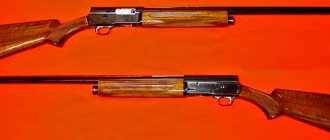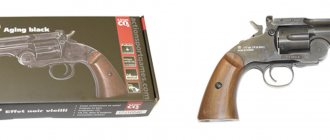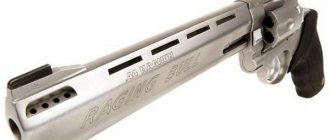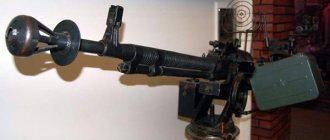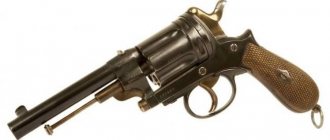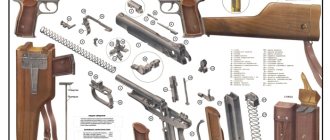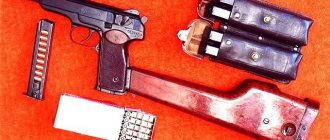With the advent of firearms and their active use, people for a long time did not think about the volume of shots fired, today we are considering the Stechkin OTs-38 revolver. But first, a little background.
The first work on the development of silencers began only at the end of the 19th century, since the Second World War showed that the silence of saboteurs was an effective force. And although almost the world’s weapon developers tried to ensure the “quiet” use of weapons, the results were disappointing. Silencers significantly increased the length of the barrels, which was not always convenient, and the volume of the shots still remained quite high.
Revolver “for silent shooting” by the Mitin brothers
The creators of the first Soviet silencer "BrahMit" even earlier tried to make the Nagan revolver silent, since this was the only weapon at that time that did not allow powder gases to escape from the breech, locking them in the barrel. Thus, it was possible to significantly reduce the strength of the sound wave from the shot. Today there is no reliable information about whether at least one experimental model of a silent revolver has been created. Everything that is known about this design is preserved in the patent description and several drawings from 1929.
Nevertheless, there was such an idea. But, as follows from the surviving information, the Nagan needed to be thoroughly redesigned, even down to reducing the caliber of the ammunition. The most interesting thing was that the main modernization concerned the barrel, at the end of which a kind of second drum was placed. When fired, the ammunition casing remained in this cartridge due to the fact that the exit diameter allowed only the bullet to pass through. The powder gases were locked in the cartridge case and gradually released through special holes, which ensured some silent shooting.
Content
- 1 History 1.1 Charging methods
- 9.1 Dardik's Thround
- 10.1 Cowboy shooting
- 11.1 Revolvers with a large number of charges
- 13.1 Austria
SP-4 cartridge
Even before the Great Patriotic War, in the early 40s, Tula designer E.M. Gurevich developed a special cartridge that allowed the powder gases to be locked in the cartridge case, ensuring silent firing. After the war, USSR designers refined and developed several types of special cartridges (SP). Thus, in the eighties, the KGB and special army and intelligence units received the PSS silent pistol and the NRS shooting knife, which were developed specifically for the SP-4.
Here we should note a rather interesting solution of locking powder gases in the cartridge case, which do not leave it. If in ordinary cartridges after the priming hole there is gunpowder and the bullet itself, then in SP-4 there is a special piston between the gunpowder and the bullet. At the moment of firing, the powder gases push the piston, and it pushes out the bullet, blocking the exit to the gases. It was for this ammunition that the Stechkin OTs-38 revolver was developed.
Bullet and blade
Speaking about small arms with a “cut-off” of powder gases, one cannot ignore such an “exotic” example as the NRS - a special reconnaissance knife. We will not get involved in periodically flaring discussions about the purpose, layout of the shooting knife, the cartridges required for it, the size and design of the blade, etc. We only note that the main goal of developing the NRS was to increase the number of “silent” barrels in reconnaissance and sabotage units.
By that time, the type of scout knife, combining the qualities of a bladed weapon and a working tool for field conditions, had long been known. In the 70s, on instructions from the Ministry of Defense and the KGB of the USSR, work began on creating a special knife equipped with a shooting device. That is, the knife turned into a combined weapon with special capabilities.
Revolver Stechkin OTs-38 “Grump”
In 1996, the Central Design Research Bureau for Sports and Hunting Weapons (TsKIB SOO) received technical assignments from law enforcement agencies to develop a revolver for silent firing with SP-4 cartridges. The project was named “Grump”, and the finished product was given the index OTs-38. I. Ya. Stechkin was appointed chief designer.
In appearance, the Stechkin OTs-38 revolver is practically no different from the classic models. However, in fact, the OTs-38 has a number of design features that are unique to it. This is understandable, because the revolver was developed specifically for the special services.
So, the barrel axis is located below the cylinder axis, which is not entirely common when it comes to revolvers in general. But this solution made it possible to significantly reduce the recoil force and increase shooting accuracy, coupled with a high rate of fire. That is, the shot in the Stechkin OTs-38 “Grump” revolver is fired from the lower chamber of the drum, and not from the upper one. In addition, above the barrel there is a laser target pointer (LTS), which from the outside appears to be a barrel. The laser laser has virtually no effect on the size of the revolver itself, ensuring its convenient concealed carry. The target designator is turned on and off using a button near the handle with the finger of the shooting hand.
The spent cartridges, united into a single block by moon clips, are removed by tilting the drum at an angle to the right. Interestingly, in all revolvers the drum tilts to the left and parallel to the axis of the channel, and not at an angle. This implementation of reloading in the Stechkin OTs-38 revolver was implemented for a reason. Considering that the SP-4 cartridge is used with locking of powder gases, it should be noted that the cartridges are subject to slight swelling.
And although the vapors have been bled off over time, the swelling still reliably fixes them in the chambers of the drum. That is why it tilts at an angle to the right, since in this case it is more convenient to remove the clip for five bullets by clasping the barrel frame with your left hand and resting your thumb on the drum, and removing the clip with your right. That is, it will not be possible to reload the OTs-38 quickly using the classical method, since some force is required, which is difficult to apply on the left side.
Another feature of the Stechkin OTs-38 “Grunt” revolver, which distinguishes it from other revolvers, is a mechanical safety that can be turned on when the hammer is cocked. But, as many believe, it is completely unnecessary in this weapon; moreover, its location requires the use of both hands - one to hold the trigger, the other to remove the safety. This is not entirely convenient, and, most likely, it was the customer’s requirement, and not the designer’s idea.
OTs-38 is the last work created by the famous Stechkin. The Stechkin revolver is not a mass-produced or civilian weapon and is currently produced in small batches exclusively on government orders for specialized units of the FSB and the Ministry of Internal Affairs, which have been in service since 2002.
Description of the weapon design and its main features
OTs-14-4 “Groza” is an individual melee weapon, which includes an under-barrel grenade launcher and a machine gun. Its main features are due to the use of 9x39 mm ammunition, the bullpup layout and modular design.
The operation scheme of the weapon's automation as a whole is the same as the AKS-74U: powder gases are discharged through a side hole in the barrel, the gas piston combined with the bolt frame has a long stroke, and the barrel is locked by rotating the bolt. True, due to the use of a cartridge with different ballistic characteristics, the designers had to slightly change the gas exhaust system of the weapon.
The barrel of the weapon has ridged projections on which a muzzle, a clutch with a grenade launcher sight, a pistol grip or a silencer can be installed. When installing a grenade launcher, fire control of a weapon - both an assault rifle and a grenade launcher - is carried out using its trigger mechanism. A special switch allows the fighter to choose whether to shoot grenades or bullets.
The sighting devices are placed on a special bridge, which also serves as a handle for carrying the weapon. They consist of a front sight and a sector sight with an adjustable turret. In addition, the bridge is used to install optical and night sights. The grenade launcher has a separate frame sight; it allows firing along a mounted and flat trajectory. The maximum firing range of a grenade launcher is 400 meters.
A butt plate with a rubber shock absorber is attached to the rear of the receiver. A special tooth in its upper part prevents the butt plate from breaking off when firing grenades. The grenade launcher casing serves as the forend of the weapon.
The machine is fed with ammunition from a box magazine that holds 20 rounds. The cartridge cases are extracted on the right side. The sling swivels are located on the buttplate of the weapon and its receiver. The fire mode translator is completely similar to the AK and is located on the right side of the weapon.
The grenade launcher of the complex has a design similar to the GP-25.
The OTs-14 version with a machine gun and a grenade launcher is considered basic, but if desired, the complex can be used in other modifications. So, for example, to turn a weapon into an assault rifle, you need to remove the grenade launcher and muzzle, as well as the handle and trigger. Instead, another muzzle with a pistol grip is placed on the weapon. This makes it easier to control fire and increases effective firing range.
For the “small-sized assault rifle” modification, a simple bushing is installed in place of the muzzle. Installing a silencer turns the weapon into a “special assault rifle.” In this version, the muffler functions as a forend. It can be added that the subsonic speed of the bullet further contributes to reducing the noise level.
Transportation of the OTs-14 is carried out in a special plastic case, which contains all its components, as well as accessories for caring for the weapon (cleaning rod, oiler, etc.).
Minigun
At the stand of the Belarusian developer and manufacturer of small arms, the Belarusian version of the compact “minigun” was presented - the modernized GShG-7.62 machine gun.
The gas venting mechanism has been removed from the weapon: the automatic operation of the machine gun is based on the use of the energy of powder gases, vented one by one into the cylinder of a gas engine, which is located next to the barrel block - the design has become lighter and more reliable.
Now the rotation of the barrel and the operation of the machine gun are carried out only by electricity. In general, the design has become more reliable and lighter, while maintaining its main advantage - high firepower. According to a company representative, the rate of fire can be changed from 400 to 6000 rounds per minute. Thanks to this, the barrel wears out less, ammunition is saved, and it is easier to draw an aiming line.
The machine gun can be placed on both an armored car and a light vehicle. For example, buggy.
An excerpt characterizing the OTs-20 “Gnome”
“Well, Colonel,” he shouted while still driving, “I told you to light the bridge, but now someone has misinterpreted it; Everyone there is going crazy, you can’t understand anything. The colonel slowly stopped the regiment and turned to Nesvitsky: “You told me about flammable substances,” he said, “but you didn’t tell me anything about lighting things.” “Why, father,” Nesvitsky said, stopping, taking off his cap and straightening his sweat-wet hair with his plump hand, “how come you didn’t say to light the bridge when the flammable substances were put in?” “I’m not your “father,” Mr. Staff Officer, and you didn’t tell me to light the bridge! I know the service, and it’s my habit to strictly carry out orders. You said the bridge will be lit, but who will light it, I cannot know with the Holy Spirit... “Well, it’s always like this,” Nesvitsky said, waving his hand. - How are you here? – he turned to Zherkov. - Yes, for the same thing. However, you are damp, let me squeeze you out. “You said, Mr. Staff Officer,” the colonel continued in an offended tone... “Colonel,” interrupted the retinue officer, “we must hurry, otherwise the enemy will move the guns to a grape shot.” The colonel silently looked at the retinue officer, at the fat staff officer, at Zherkov and frowned. “I’ll light the bridge,” he said in a solemn tone, as if expressing that, despite all the troubles being caused to him, he would still do what he had to do. Hitting the horse with his long muscular legs, as if it were all to blame, the colonel moved forward to the 2nd squadron, the same one in which Rostov served under the command of Denisov, and ordered to return back to the bridge. “Well, that’s right,” thought Rostov, “he wants to test me!” “His heart sank and the blood rushed to his face. “Let him see if I’m a coward,” he thought. Again, on all the cheerful faces of the squadron people, that serious feature appeared that was on them while they were standing under the cannonballs. Rostov, without taking his eyes off, looked at his enemy, the regimental commander, wanting to find confirmation of his guesses on his face; but the colonel never looked at Rostov, but looked, as always at the front, strictly and solemnly. A command was heard. - Alive! Alive! – several voices spoke around him. Clinging to the reins with their sabers, rattling their spurs and hurrying, the hussars dismounted, not knowing what they would do. The hussars were baptized. Rostov no longer looked at the regimental commander - he had no time. He was afraid, with a sinking heart he was afraid that he might fall behind the hussars. His hand trembled as he handed the horse to the handler, and he felt the blood rushing to his heart. Denisov, falling back and shouting something, drove past him. Rostov saw nothing except the hussars running around him, clinging to their spurs and clanking their sabers.





